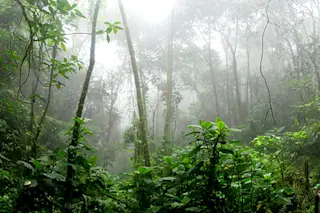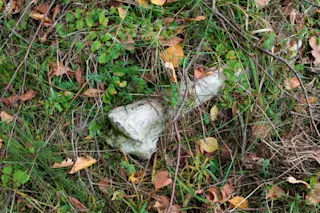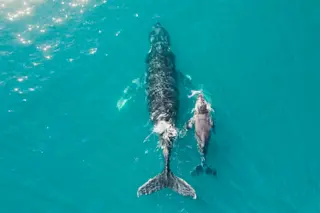In northern Colombia, in a semi-desert region that juts into the Caribbean Sea, its dusty roads traveled by the Wayúu people with their blankets and colorful backpacks, is Cerrejón — one of the largest open-pit coal mines in the world. Excavated for more than 30 years, its huge craters and twisted paths down which the trucks descend give the impression of a tropical hell.
But for the trained eyes of Carlos Jaramillo, that hell is a paradise he always dreamed of finding. There, while working for the Colombian Petroleum Institute more than 20 years ago, Jaramillo, a paleontologist and pollen expert, began with other colleagues to unearth the lost history of the Neotropical forests of the Americas — and to challenge some of the paradigms of paleontology.
Fossil after fossil, these scientists have been reconstructing a history that was thought to be impossible to discover. “For many years, it was believed that almost no fossils had been preserved in the tropics because of the high rates of weathering — the decomposition of minerals and rocks — and, if they did exist, it would be very difficult to find them because of the current forest cover,” says Jaramillo, now a researcher at the Smithsonian Tropical Research Institute in Panama.
While the geology textbooks that Jaramillo and his colleagues learned from said that tropical forests, just like temperate forests, had remained more or less stable in their plant composition for at least 120 million years, recent palaeobotanical findings suggest a very different story.
For the entire Cenozoic, the current geological era that began some 66 million years ago with the meteorite impact that wiped out dinosaurs and many of the planet’s other species, “the climate and geology of the Neotropics have been far from stable,” note ecologist Christopher W. Dick and botanist R. Toby Pennington in a review of the history and geography of Neotropical tree diversity in the 2019 Annual Review of Ecology, Evolution, and Systematics. In addition to the meteorite impact, which marked a before and after in this ecosystem, the rise of the Isthmus of Panama, the formation of the Amazon River and the uplift of the northern Andes, for example, have profoundly influenced the region’s climate, species formation and migration.
But the precise association between these events is unclear. The pieces of that story are what a new generation of scientists has set out to find.
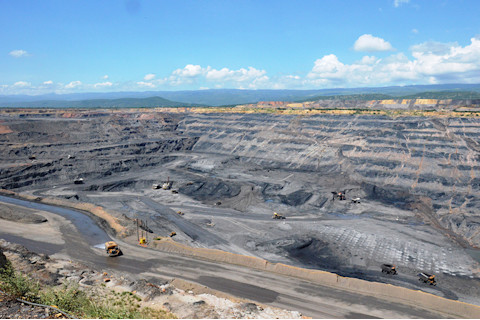
(Credit:HOUR.POING / WIKIMEDIA COMMONS) At Cerrejón, one of the world's largest open-pit coal mines, located in northern Colombia, paleobotanists have found much of the evidence for reconstructing the evolution of Neotropical forests. CC BY-SA 3.0
Messages within the pollen
A key piece in reconstructing the history of tropical forests has to do with pollen grains, which contain the male sex cells of most plants and trees; these function like nature’s clock. They are so tiny that, to study them under the microscope, some paleobotanists like to use cat’s whiskers to manipulate them. The wall that covers a pollen grain is quite resistant to temperature changes, helping its preservation for millions of years inside the rocks. And the pollen is so abundant that, although most of it is destroyed, some remains in the geological layers, waiting for a palynologist to set eyes on it. Its virtues do not end there. The shape of pollen is so diverse — circular, triangular, hexagonal, with tiny spikes or warts — that it is equivalent to a fingerprint for plants.
The first fossil signs of the evolution of tropical flora came from the work of palynologists who, in the second half of the 20th century, traveled the Neotropics alongside oil explorers. Their pollen samples and classifications, which helped them to identify potential oil exploration sites, remained far from the gaze of other scientists due to commercial interests.
One of Jaramillo’s studies, together with paleobotanist Paula Mejía Velásquez, now with Leeward Community College in Hawaii, consisted of reviewing two such cores. Drilled by ExxonMobil in the region of Los Mangos, the samples remained ignored for decades in the National Rock Library of the Colombian Petroleum Institute. The cores, some 600 to 700 meters long, contained a pollen chronology that spanned the early Cretaceous, some 120 million years ago, to the present. And within them, the scientists found a powerful reason to continue their research into that remote past: The flowering plants, or angiosperms, which today comprise more than 96 percent of the Neotropical forest, were less than 7 percent at the beginning of the Cretaceous.
“There, I had a logical place to start,” Jaramillo says. “The story I wanted to study is how we went from an ecosystem where there were almost no angiosperms to a forest with 96 percent angiosperms. That is the story of a fundamental change in an ecosystem.”

(Credit:INGRID ROMERO/Knowable Magazine) View of the outer wall of a fossil pollen grain corresponding to the species Echiperiporites that was present in the Miocene (23 million years ago). The image was obtained by high-resolution microscopy.
It is easy to forget how crucial flowering plants are to the survival of so many animal species, including us, wrote paleobotanist Peter Crane, former director of the Field Museum in Chicago and the Royal Botanic Gardens, Kew, in London, in 2010: “Angiosperms provide the energy on which most of the rest of biological diversity depends. The evolution of flowers and flowering plants is therefore both of fundamental significance and of contemporary relevance.”
Charles Darwin himself, in a very famous letter to his friend Joseph Hooker, described the relatively late and apparently sudden appearance of flowering plants as “an abominable mystery.” This abrupt arrival was contrary to his postulates on evolution, according to which changes occurred gradually. In the letter written in July 1879, three years before his death, he commented that he would “like to see this whole problem solved.”
Around 2002, when Jaramillo was working for the Colombian Petroleum Institute, a pair of fossil-loving geology students, Fabiany Herrera and Edwin Cadena — more enthusiastic than well-trained in paleontology — joined the fossil hunt to help unravel the whole story of the Neotropical forests’ past.
Herrera, now assistant curator of paleobotany at the Field Museum, followed Jaramillo’s advice and traveled to Cerrejón to look for a ghost: fossil leaves from the early Cenozoic. In pits up to 2 kilometers in diameter that had been abandoned by the miners, with a geological hammer in hand, smashing one rock after another, Herrera unearthed a palaeobotanical treasure trove: more than 2,000 fossil plants.
Cadena, the other student who had joined the adventure, turned his attention to other residents of those archaic forests. Cerrejón held many hidden surprises: fossils of turtles, crocodiles and giant snakes. In 2009, for example, the remains of a snake measuring 12.8 meters and weighing approximately 1,135 kilograms were discovered there. Named Titanoboa cerrejonensis, it crawled through these ecosystems some 58 million to 60 million years ago, according to the report on the discovery published in Nature. Fossils of these and other animals offer clues about the conditions in these past habitats.
“My role has been to understand how animals, particularly reptiles, relate to these ecosystems and to validate the conditions of temperature, precipitation and other characteristics that we deduce,” explains Cadena, a paleontologist at the Rosario University in Bogota. For example, in the case of a snake like the Titanoboa, its size would require a minimum average annual temperature of 30 to 34 degrees Celsius to survive.
“That feeling of hopelessness, that in the Tropics nothing is preserved, that we would not find the fossils we needed, began to disappear with the visits to Cerrejón,” says Jaramillo.
In the decades that followed, other researchers joined the effort to rewrite the history of Neotropical forests. The exploration sites also expanded: Magdalena River Valley, the Ecuadorian and Colombian Amazon, central Peru, and parts of Argentina and Chile. In 2009, when the Panama Canal expansion began, the researchers took advantage of this new window into the geological depths to continue gathering clues to the past of the forests.
The great impact
The fossil evidence that Jaramillo and his colleagues have collected over three decades, at some 50 sites in the Tropics, is providing a better understanding of how and when these cathedrals of biodiversity — the most species-diverse ecological communities in the world — were formed. It has also made it possible to outline how the varieties of plant and animal species has changed; and how they transformed and reacted to the great extinction caused 66 million years ago by the impact of a meteorite in the Yucatan Peninsula that left the Chicxulub crater. With the power of close to a billion bombs of the size dropped on Hiroshima, it led to the extinction of about 76 percent of all marine species and 40 percent of the genera present on the planet at that time.
What were the forests like before and after that impact, a chapter of history known to geologists as the K/Pg boundary, the boundary between the Cretaceous and the Paleogene?
Analysis of 6,000 fossil leaves and 50,000 pollen grains collected from 46 sites — including, of course, Cerrejón, as well as coal mines in central Colombia and the Amazon — have revealed a snapshot of forests 66 million years ago.

(CREDIT: M.R. CARVALHO ET AL / SCIENCE 2021) Collage of fossilized plants discovered in several locations in South America and published in the journal Science as part of the evidence on the evolution of Neotropical forests.
In those forests where dinosaurs roamed, a more equitable community of plants lived together. The space was distributed among ferns (50 percent), flowering plants (40 percent) and trees such as araucarias and conifers. The flora did not form the tangled, layered structure of the Neotropical forests today. Light filtered down to the ground, unblocked by the jungle canopy we see today, explains Mónica Carvalho, a paleobotanist and curator at the Museum of Paleontology at the University of Michigan, who with Jaramillo led a study, published in 2021 in the journal Science, that summarizes these findings.
Another difference that these fossils tell us of was a lower contribution, to the atmosphere, of water released by plants. For a paleobotanist like Carvalho, this can be deduced from the length, thickness and patterns of the veins stamped on a fossil leaf, since they provide clues about the metabolism of these plants. And the bites imprinted on these fossil leaves reveal other forest inhabitants — insects — and their ecological interactions. While the insect communities that inhabited these forests before the great extinction were more specialist — one type of insect feeding on one specific type of plant — the post-extinction insects are more generalist: You see the same kinds of damage or bites on almost every plant.
Only after the meteorite did legumes, capable of capturing — or fixing — nitrogen from the air, become as abundant as they are today, which would explain profound changes in soil fertility. However, all this radical change in plant composition was a slow process. After the meteorite, it took at least 7 million years for the forests to recover and surpass the degree of plant diversity present before the impact.
“Thanks to this, we now know that, although flowers diversified in the dinosaur era, they took longer to come to dominate the forest, and that evolutionary opportunity arose for them, thanks to the ecological catastrophe unleashed by the asteroid,” says Carvalho.
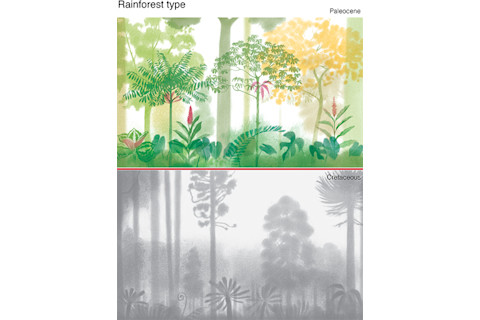
(CREDIT: M.R. CARVALHO ET AL / SCIENCE 2021) Artistic reconstruction of the appearance of tropical forests before (Cretaceous) and after (Paleocene) the meteorite impact on the Yucatan Peninsula 66 million years ago. The reconstruction is based on the analysis of 6,000 fossil leaves and 50,000 pollen grains collected from 46 sites in South America.
Why were those pre-impact forests different from today's forests? In the Science article, Carvalho and colleagues pose three possible answers to that question. A first hypothesis suggests that herbivorous dinosaurs exerted control over the forest; with their disappearance, the ecosystem balance was broken. The second hypothesis refers to the nutrient composition of the soil, which is suspected to have been less fertile before the cataclysm. The ashfall after the Chicxulub impact changed the balance of minerals, providing, for example, more phosphorus. A third hypothesis raises the possibility of a selective extinction that affected conifer lineages — which inhabited smaller ecological ranges — more than angiosperm lineages, which found an opportunity to expand.
"The whole story that this data tells us is incredible," Jaramillo says. "To know that the forest of today is the product of a precise instant, millions of years ago, of a particular minute, is fantastic."
Forests and climate change
Beyond understanding the dramatic changes these forests underwent after the Chicxulub meteorite impact, the study of their past is also allowing scientists to decipher how the Neotropical forests have reacted to changes in temperature and higher CO2 levels, data that may provide clues about what may happen to these ecosystems in the face of global warming.
Read More: The Amazon Rainforest Could Die in Your Lifetime — Here's Why
One answer lies in the Eocene, which began 56.3 million years ago when a phenomenon known as the Paleocene-Eocene Thermal Maximum (PETM) occurred. This short-lived global warming event, the fastest in the last 140 million years, involved a global temperature increase of 5 to 7 degrees Celsius over 10,000 to 50,000 years, Jaramillo describes in one of the chapters of the book The Geology of Colombia. This is the best analog to modern human-induced warming, except that the PETM developed slower than today's warming, allowing many species to adapt. It occurred because of volcanism in the North Sea, which led to the addition of some 1,300 ppm of CO2 to an atmosphere that previously had averaged 500 ppm of CO2.
"Although plants can migrate to higher latitudes to escape warming, extinctions in the Tropics would be expected, as the temperature would stress plants beyond their survival limit," says Jaramillo. But what Jaramillo and his colleagues found when they analyzed the fossil record from three sites in northeastern Colombia and northwestern Venezuela was quite different. As mean annual temperature increased (by between 3.5 and 5 degrees Celsius) during the PETM, in the northern lowlands of the Neotropics, "the rate of origin of new species doubled, while extinction rates remained unchanged." This increase in temperature resulted in 30 percent more diverse vegetation. Epiphytic ferns, typical of Neotropical forests, and orchids and leaf-cutter ants also took advantage of the energetic bonanza of more CO2, and greater diversity was observed among them.

(CREDIT: FELIPE VILLEGAS / HUMBOLDT INSTITUTE) Colombian paleontologist Carlos Jaramillo (center, facing front) with a group of scientists during a field trip to the Tatacoa Desert, Colombia.
Jaramillo believes that these results contradict global paleoclimatic models that predict a collapse of Neotropical vegetation due to heat stress. In an article he coauthored in the 2013 Annual Review of Earth and Planetary Sciences, he noted that in a compilation of 5,998 empirical estimates of temperature over the past 120 million years, “the Tropical Rain Forest did not collapse during past warmings; on the contrary, its diversity increased. The increase in temperature seems to be a major driver in promoting diversity.”
Does this mean that, contrary to apocalyptic forecasts, Neotropical forests could experience a biological bonanza during today’s global warming? Not necessarily. The speed at which humans are causing the accumulation of greenhouse gases is different from that of the PETM, which developed more slowly. Jaramillo says it is not possible to know whether plants under the current scenario would be able to adapt given the sheer speed of change.
However, for Jaramillo, there are signs for optimism — at least regarding the fate of plants. “The genes that regulate photosynthesis are deeply rooted in plant phylogeny and we would expect the physiological function to be similar in Eocene and present-day plants,” he says. In other words, modern plants carry in their DNA the genetic variability to cope with increases in temperature and CO2, he notes, “as long as there is enough water in the soil. Water, then, is the key factor to consider in the tropical biomes of the future.”
“Of course, as all good research does, it also begs some further questions,” says Crane, now president of the Oak Spring Garden Foundation, of the work of Jaramillo and his colleagues. Many of these questions, Crane adds, are related to the evolution of flowering plants: What was happening in the late Cretaceous before the meteorite? What was the vegetation like? How did angiosperms evolve before the meteorite impact, before they dominated the forest? Which groups were involved and what kind of ecological communities did they create? And how did those communities take the forest from having essentially no flowering plant trees to having a great variety of flowering plant trees?
But the most urgent and dramatic of the questions on Crane’s list is how forests will react to the unusual changes in global climate that we humans are causing. No one has a definitive answer. What we do know is that plants conquered this planet 470 million to 500 million years ago. We know that 430 million years ago, they caused an explosion of diversity and shaped the biosphere by reducing atmospheric CO2 by eight to 20 times. We know that they have survived five mass extinctions, including the one caused by the meteorite.
Plants have always found a way to survive, as Jaramillo explains. On this planet, the inexperienced and new ones are we humans, who appeared less than 300,000 years ago, on one of the smaller branches of the tree of life.
Article translated by Debbie Ponchner
10.1146/knowable-112822-1
Pablo Correa is a Colombian science journalist and former science, environment and health editor of the Colombian newspaper El Espectador. He was a Knight Science Journalism Fellow at MIT in 2012-2013. He is the author of the book Rodolfo Llinás, la pregunta difícil.
This article originally appeared in Knowable Magazine, an independent journalistic endeavor from Annual Reviews.


